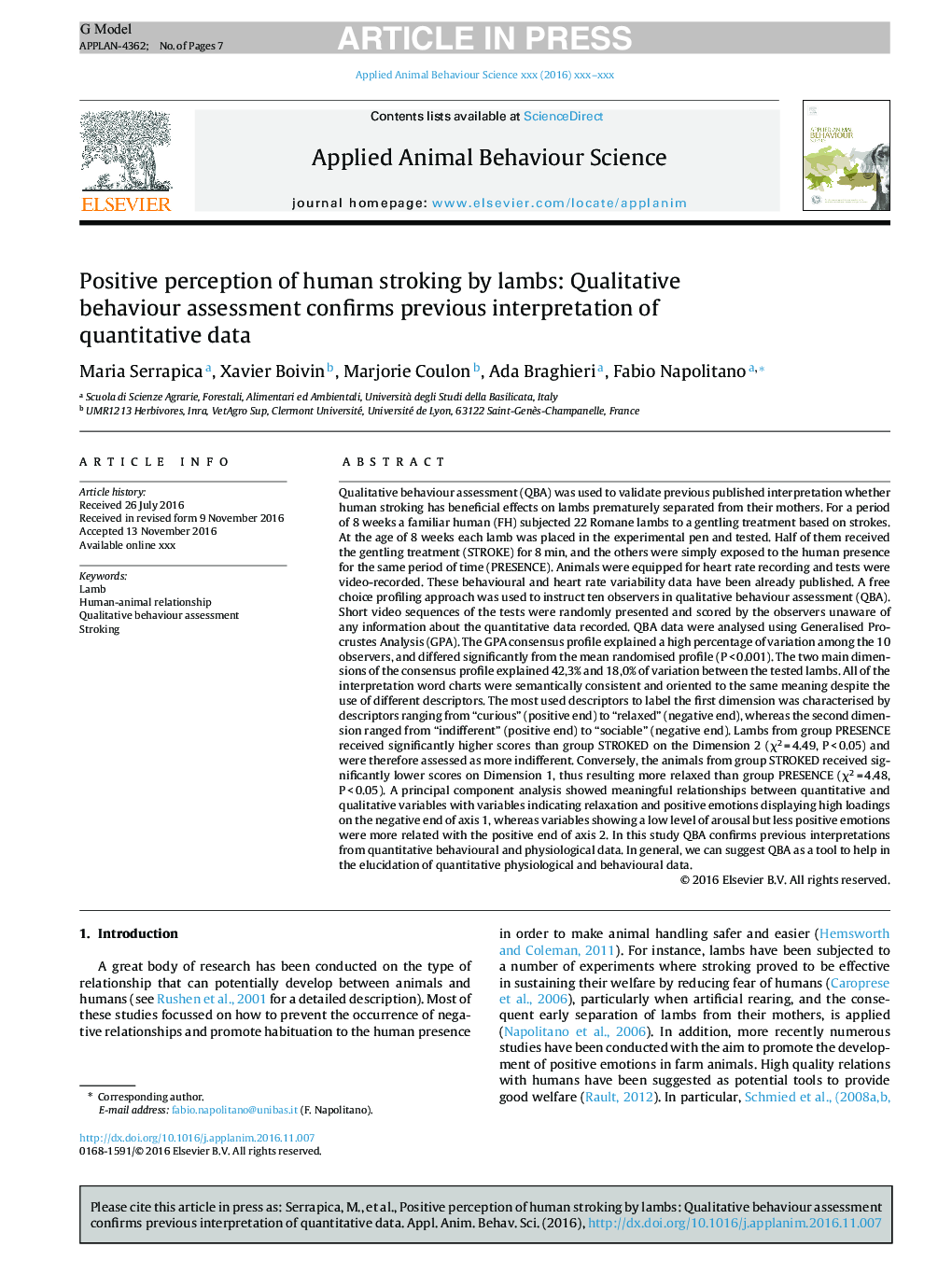| کد مقاله | کد نشریه | سال انتشار | مقاله انگلیسی | نسخه تمام متن |
|---|---|---|---|---|
| 5763318 | 1625319 | 2017 | 7 صفحه PDF | دانلود رایگان |
عنوان انگلیسی مقاله ISI
Positive perception of human stroking by lambs: Qualitative behaviour assessment confirms previous interpretation of quantitative data
ترجمه فارسی عنوان
درک مثبت از انگیختن انها توسط بره ها: ارزیابی رفتار کیفی، تفسیر قبلی داده های کمی را تایید می کند
دانلود مقاله + سفارش ترجمه
دانلود مقاله ISI انگلیسی
رایگان برای ایرانیان
کلمات کلیدی
گوشت بره، ارتباط انسان و حیوانات، ارزیابی رفتار کیفی، نوازش کردن،
موضوعات مرتبط
علوم زیستی و بیوفناوری
علوم کشاورزی و بیولوژیک
علوم دامی و جانورشناسی
چکیده انگلیسی
Qualitative behaviour assessment (QBA) was used to validate previous published interpretation whether human stroking has beneficial effects on lambs prematurely separated from their mothers. For a period of 8 weeks a familiar human (FH) subjected 22 Romane lambs to a gentling treatment based on strokes. At the age of 8 weeks each lamb was placed in the experimental pen and tested. Half of them received the gentling treatment (STROKE) for 8Â min, and the others were simply exposed to the human presence for the same period of time (PRESENCE). Animals were equipped for heart rate recording and tests were video-recorded. These behavioural and heart rate variability data have been already published. A free choice profiling approach was used to instruct ten observers in qualitative behaviour assessment (QBA). Short video sequences of the tests were randomly presented and scored by the observers unaware of any information about the quantitative data recorded. QBA data were analysed using Generalised Procrustes Analysis (GPA). The GPA consensus profile explained a high percentage of variation among the 10 observers, and differed significantly from the mean randomised profile (PÂ <Â 0.001). The two main dimensions of the consensus profile explained 42,3% and 18,0% of variation between the tested lambs. All of the interpretation word charts were semantically consistent and oriented to the same meaning despite the use of different descriptors. The most used descriptors to label the first dimension was characterised by descriptors ranging from “curious” (positive end) to “relaxed” (negative end), whereas the second dimension ranged from “indifferent” (positive end) to “sociable” (negative end). Lambs from group PRESENCE received significantly higher scores than group STROKED on the Dimension 2 (Ï2Â =Â 4.49, PÂ <Â 0.05) and were therefore assessed as more indifferent. Conversely, the animals from group STROKED received significantly lower scores on Dimension 1, thus resulting more relaxed than group PRESENCE (Ï2Â =Â 4.48, PÂ <Â 0.05). A principal component analysis showed meaningful relationships between quantitative and qualitative variables with variables indicating relaxation and positive emotions displaying high loadings on the negative end of axis 1, whereas variables showing a low level of arousal but less positive emotions were more related with the positive end of axis 2. In this study QBA confirms previous interpretations from quantitative behavioural and physiological data. In general, we can suggest QBA as a tool to help in the elucidation of quantitative physiological and behavioural data.
ناشر
Database: Elsevier - ScienceDirect (ساینس دایرکت)
Journal: Applied Animal Behaviour Science - Volume 187, February 2017, Pages 31-37
Journal: Applied Animal Behaviour Science - Volume 187, February 2017, Pages 31-37
نویسندگان
Maria Serrapica, Xavier Boivin, Marjorie Coulon, Ada Braghieri, Fabio Napolitano,
